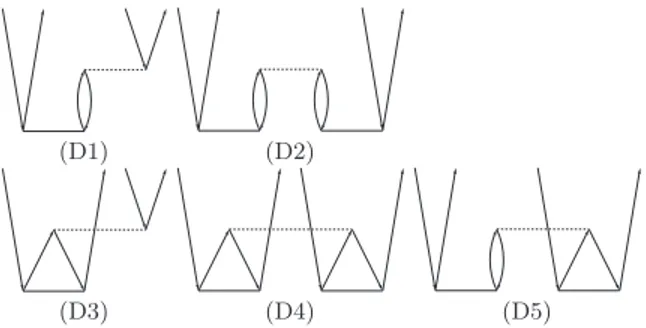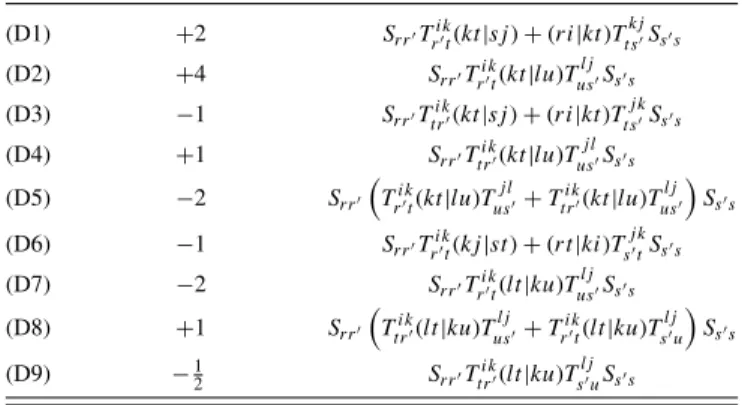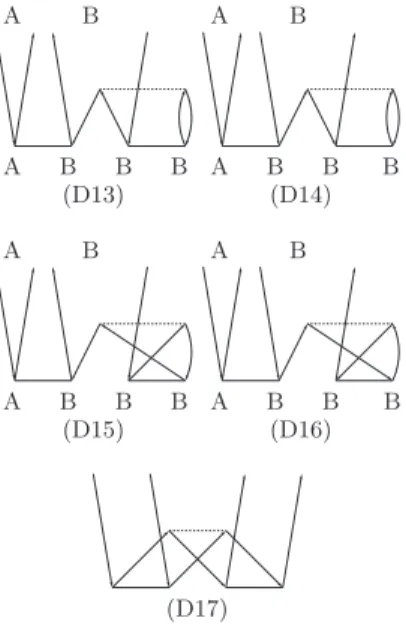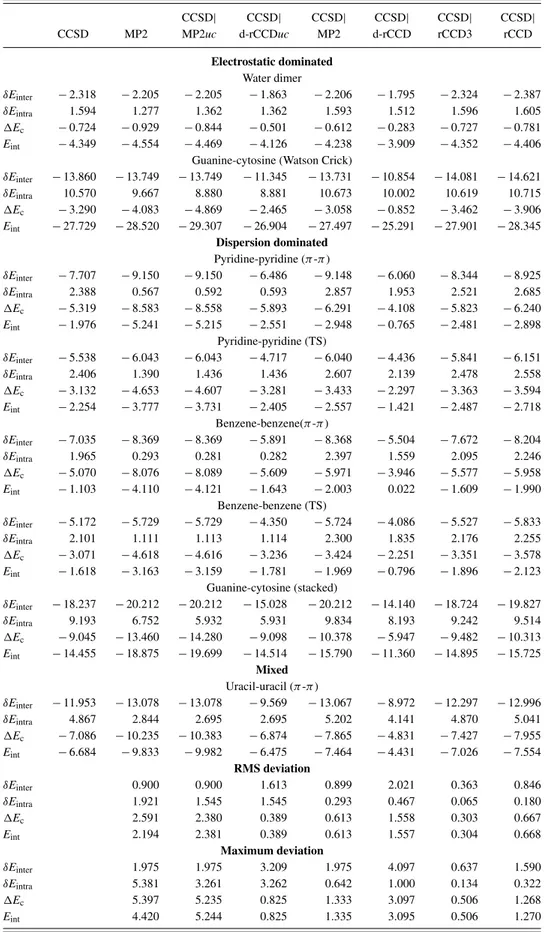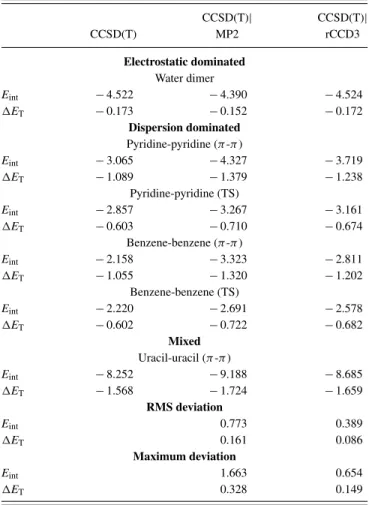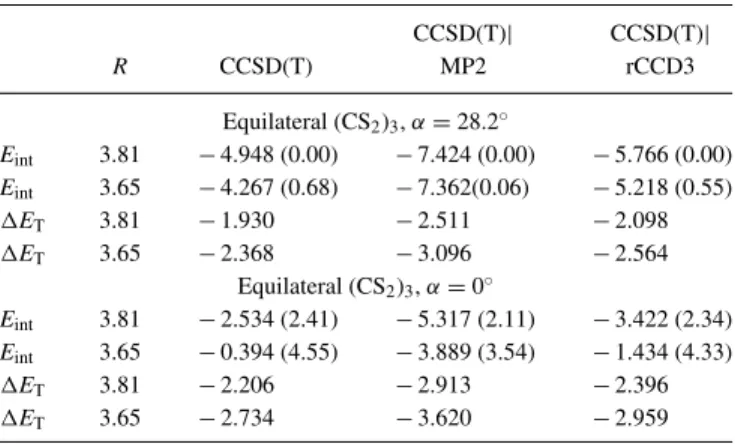Oliver Masur, Denis Usvyat, and Martin Schütz
Citation: The Journal of Chemical Physics 139, 164116 (2013); doi: 10.1063/1.4826534 View online: http://dx.doi.org/10.1063/1.4826534
View Table of Contents: http://scitation.aip.org/content/aip/journal/jcp/139/16?ver=pdfcov Published by the AIP Publishing
Articles you may be interested in
Analytic energy derivatives for the calculation of the first-order molecular properties using the domain-based local pair-natural orbital coupled-cluster theory
J. Chem. Phys. 145, 114101 (2016); 10.1063/1.4962369
Orbital-optimized MP2.5 and its analytic gradients: Approaching CCSD(T) quality for noncovalent interactions J. Chem. Phys. 141, 204105 (2014); 10.1063/1.4902226
Efficient and accurate treatment of weak pairs in local CCSD(T) calculations. II. Beyond the ring approximation J. Chem. Phys. 140, 244107 (2014); 10.1063/1.4884156
An efficient linear-scaling CCSD(T) method based on local natural orbitals J. Chem. Phys. 139, 094105 (2013); 10.1063/1.4819401
Efficient and accurate local approximations to coupled-electron pair approaches: An attempt to revive the pair natural orbital method
J. Chem. Phys. 130, 114108 (2009); 10.1063/1.3086717
Reuse of AIP Publishing content is subject to the terms: https://publishing.aip.org/authors/rights-and-permissions. Downloaded to IP: 132.199.145.239 On: Wed, 19 Oct
THE JOURNAL OF CHEMICAL PHYSICS139, 164116 (2013)
Efficient and accurate treatment of weak pairs in local CCSD(T) calculations
Oliver Masur, Denis Usvyat, and Martin Schütza)
Institut für Physikalische und Theoretische Chemie, Universität Regensburg, Regensburg D-93040, Germany (Received 1 August 2013; accepted 9 October 2013; published online 28 October 2013)
Local coupled cluster theory is based on (i) a restriction of the list of pairs (or triples) of occu- pied molecular orbitals, and (ii) a truncation of the virtual space to orbital pair (or triple) specific subspaces. The latter is motivated by an exponential decay of the contributions to the pair energy with respect to the distance between related local occupied and virtual orbitals; the former only by a polynomialR−6decay with respect to the distanceRbetween the two occupied orbitals of the pair.
Consequently, the restriction of the pair list is more critical, and contributions of pairs should not be neglected unless the corresponding interorbital distance is really large. In local coupled cluster theory pairs are usually discriminated on the basis of the interorbital distance, or the size of the 2nd order Møller-Plesset perturbation theory (MP2) estimate of the pair energy. Only strong pairs are treated at the full coupled cluster level, while weak pairs are treated just at the level of MP2. Yet MP2 might be problematic in certain cases, for example, π-stacking is badly described by MP2, etc. We propose to substitute the MP2 treatment of weak pairs by an approach based on ring-CCD by including third-order diagrams withR−6decay behavior. Such an approach is clearly superior; it provides higher accuracy, while the computational cost is not significantly higher than that of a MP2 based treatment of weak pairs.© 2013 AIP Publishing LLC. [http://dx.doi.org/10.1063/1.4826534]
I. INTRODUCTION
Coupled Cluster (CC) theory is probably the most suc- cessfulab initioelectronic structure method to treat dynamic electron correlation effects.1,2 The exponential wavefunction ansatz|CC =exp(T)|0, whereTis the cluster operator, and
|0the reference (usually Hartree-Fock) determinant, ensures size extensivity. Moreover, it introduces all excited determi- nants of full configuration interaction (FCI) not covered by the truncated cluster operatorTinto |CC, with coefficients factorized into products of amplitudes already included inT.
Truncated CC theory therefore can be regarded as an approx- imation to FCI based on a special tensor factorization of the FCI coefficients containing all FCI determinants. CC with sin- gles and doubles substitutions,T=T1+T2, and ana poste- rioriperturbative treatment of triples substitutions, CCSD(T), has become the “Gold Standard” in quantum chemistry (this expression is attributed to Dunning). For single reference cases, chemical accuracy is reached with this method, pro- vided that sufficiently large basis sets (eventually combined with basis set extrapolation techniques) are employed.
Canonical CCSD(T) has a computational cost ofO(N7) relative to the molecular size N, i.e., O(N6) for the it- erative CCSD calculation, and O(N7) for the a posteriori perturbative triples correction (T). In order to defeat this un- favorably high scaling wall and to make the method also applicable to extended molecular systems, local CCSD(T) methods were developed during the past fifteen years.3–9The term “local” here implies the formulation of CCSD(T) in terms of spatially localized occupied and virtual molecular or- bitals (MOs), rather than the commonly used delocalized and
a)Electronic mail: martin.schuetz@chemie.uni-regensburg.de
symmetry-adapted canonical orbitals diagonalizing the Fock matrix. Local MOs spanning the occupied space (LMOs) are usually obtained by applying a localization procedure such as Pipek-Mezey10 or Boys11 to the occupied canonical orbitals obtained from the preceding Hartree-Fock calculation. For the virtual space, e.g., projected atomic orbitals (PAOs),12–17 orbital specific virtuals (OSVs),6,18–21 or pair natural or- bitals (PNOs)22–29 can be used, either exclusively, or also in combination.
A formulation of CCSD(T) in terms of such local orbitals allows for a dramatic reduction of the determinants and re- lated amplitudes entering the cluster operatorT, which is es- sentially based on (i) truncations of the virtual space, and (ii) pair approximations.3,5,30Truncations of the virtual space are enforced by allowing only, e.g., doubles substitutions from a certain LMO pair to PAOs in the immediate spatial vicinity of these two LMOs, or to OSVs related to either one of these two LMOs, or to PNOs related to this LMO pair. This is mo- tivated by an exponential decay in the related amplitudes with respect to the distance between LMOs and local virtuals.
Pair approximations, on the other hand, discriminate in- dividual LMO pairs and assign them to the pair classes of strong,weak, etc., pairs on the basis of their interorbital dis- tanceR: onlystrongpairs are treated at the CC level, while weakpairs are treated at a lower level of theory, typically at the level of second-order Møller-Plesset perturbation theory, MP2. A subset of weak pairs, denoted as closepairs, con- tribute, together with strong pairs, to the triples residual, and, optionally, to the (strong pair) doubles residual.
Pair approximations are motivated by theR−6decay be- havior of the individual pair energies with respect to the dis- tance Rbetween the respective LMOs, combined with per- turbation theory arguments. It is assumed that the third- and
0021-9606/2013/139(16)/164116/10/$30.00 139, 164116-1 © 2013 AIP Publishing LLC
higher order (within the MP partitioning) contributions to the weak pair energies are negligibly small. However, R−6 is a much weaker decay than the exponential one, that mo- tivates truncations of the virtual space; the pair approxima- tion hence has to be considered as more severe than the latter approximation. For example, it is well known that MP2 does not provide a sufficiently accurate description for the inter- action between two π-stacked aromatic ring systems. MP2 often either underestimates (for systems with low polariz- ability) or overestimates (for systems with high polarizabil- ity) the interaction energies in intermolecular complexes and clusters.31–34 Also, non-additive dispersion (Axilrod-Teller) contributions are not covered at the MP2 level. Hence, al- though many approximated CCSD schemes for extended sys- tems explicitly3–5,21,35,36or implicitly37employ the MP2-like treatment for most of the pairs (similar to the weak pair ap- proximation in the present context), it is questionable, if such a treatment provides in general sufficient accuracy.
In the present paper we investigate the accuracy of pair approximations for a set of diverse intermolecular complexes and clusters. On the basis of our results we propose to substi- tute the LMP2 treatment of weak pairs by a method based on ring-CCD38–40 [ring-CCD is equivalent to the random phase approximation (RPA)39,41], with additional exchange terms such that the antisymmetry of the amplitudes in a spin-orbit formalism remains intact. In Sec. II we briefly outline the formalism of such a ring-CCD-based approach. In Sec. III we compare its performance, for a set of test systems, to the previous approach with weak pairs treated at the MP2 level.
SectionIVfinally concludes this paper.
II. THEORY
In this section we first briefly define the general nomen- clature and provide the CCSD residual equations for the strong pairs. Afterwards, the diagrams included in the dif- ferent treatments of the weak pairs are discussed. As usual, indices i,j, k,l denote in the following localized occupied molecular orbitals (LMOs), while indicesr,s,t,udenote lo- calized virtual orbitals, i.e., PAOs. For other choices of local- ized virtuals like OSVs or PNOs the formulae are very similar and straightforwardly obtained from those presented here for PAOs.
A. The LCCSD residual for strong pairs
The LCCSD residual, defining the equations to be solved for the strong pair amplitudes, is given by
rri =
˜rie−TˆH eˆ Tˆ|0 =0; ∀i;r∈[ii], (1)
Rrsij =˜rsije−TˆH eˆ Tˆ|0 =0; ∀ij ∈ {s};r, s∈[ij], (2) with ˆH =Fˆ+Vˆthe normal ordered Hamiltonian (consisting of Fock operator ˆFand fluctuation potential ˆV), ˆT =Tˆ1+Tˆ2 with
Tˆ1 =
i
r∈[ii]
triEˆri, (3)
Tˆ2= 1 2
ij∈{s}
rs∈[ij]
TrsijEˆriEˆsj, (4)
|0 the Hartree-Fock reference wavefunction, and ˜ai|, ˜abij|the contravariant configuration state functions,
˜ri=1
20|Eˆri†, (5) ˜rsij= 1
60|(2 ˆEri†Eˆsj† +Eˆrj†Eˆsi†), (6) used for projection. The ˆEri denote spin-conserving one- particle excitation operators, and thetriandTrsij are the singles and doubles amplitudes, respectively.
Note that in Eqs. (1)–(4) the ranges of virtuals are re- stricted to “pair domains” [ij], related to individual LMO pairs ij(in case of singles a diagonal pair). The detailed construc- tion of these pair domains of course depends on the choice of the virtuals, i.e., whether PAOs, OSVs, or PNOs are em- ployed. Furthermore, and what is of greater relevance for the present discussion, in Eqs.(2)and(4)the range of LMO pairs ijis restricted to the list of strong pairs {s}. As already men- tioned in the Introduction, the assignment of the individual pairs to the distinct pair classes (strong, weak, distant) is usu- ally done on the basis of the LMO interorbital distances, or connectivities.5,30 In the latter case just the number of bonds between two LMOs is counted. Alternatively, it would also be possible to assign individual pairs to pair classes on the ba- sis of the respective pair energies of, e.g., a preliminary MP2 calculation comprising all pairs.
In the present work we employed an assignment on the basis of distances: each LMO specifies its own subset of rele- vant atoms. This is obtained from a Löwdin population analy- sis by truncating the ordered atoms list beyond a certain pop- ulation. The LMO distance then is defined as the distance between the two closest atoms of the two respective atom subsets. Typically, only LMO pairs with mutual overlapping atom subsets are considered as strong. Sometimes also en- larged strong pair lists with distances up to 3 bohrs are em- ployed. The amplitudes of the remaining pairs are usually cal- culated at the level of MP2. To this end, the LMP2 amplitude equations,
Rijrs=˜rsijVˆ +[ ˆF ,Tˆ2]|0 =0; ∀ij ∈ {sw};r, s∈[ij], (7) are ordinarily calculated initially (before the actual LCCSD calculation) for all pairs ij ∈ {sw} (strong + weak). The strong pairs are subsequently refined by solving the LCCSD equations(1)and(2).
Optionally, some of the weak pair LMP2 amplitudes (be- longing to the subset ofclose pairs) can enter these equations and so couple with the strong pair amplitudes. In other words, the sum overijpairs in Eq.(4)now runs over the combined list of strong and close pairs {sc}={s}∪{c}, rather than just over {s}. Actually, as demonstrated in Sec.III, it is indeed highly advisable to do this. On the other hand, strong pair amplitudes can only contribute to the LMP2 residual(7)via the term in- volving the Fock operator ˆF. Since the matrix representation
Reuse of AIP Publishing content is subject to the terms: https://publishing.aip.org/authors/rights-and-permissions. Downloaded to IP: 132.199.145.239 On: Wed, 19 Oct
164116-3 Masur, Usvyat, and Schütz J. Chem. Phys.139, 164116 (2013)
of the latter is diagonally dominant these couplings are very weak and can be neglected. Therefore, no further iteration be- yond the initial LMP2 calculation is necessary.
Finally, after convergence of the LCCSD equations(1) and(2)for strong pairs also ana posteriorilocal triples cor- rection L(T), or L(T0) can be evaluated. The corresponding formulae can be found in Refs.3,4, and6, and are not reiter- ated here. We just mention at this point that strong and close pair amplitudes enter the triples residual.
B. The ring-CCD (rCCD) and rCCD3 residual for weak pairs
A LMP2 treatment of weak pairs of course is compu- tationally very efficient. However, as already pointed out in the Introduction, it may not always provide satisfactory accu- racy. In the course of the present work we have devised, im- plemented, and tested alternative methods for the treatment of these pairs, based on the ring-CCD (or rCCD for brevity) approach.
Several versions of ring-CCD were already considered in Refs.39and40. The main motivation for the introduction of this approach in these papers is its equivalence to RPA. In particular, to preserve this equivalence the antisymmetry of the doubles amplitudes in spin-orbital basis with respect to permutation of the occupied or virtual indices is sacrificed.
Yet in the present work we employ this method as an approx- imation to the CCSD method for weak pairs, without explicit reference to RPA, and therefore there is no need to drop the antisymmetry of the amplitudes. What is even more impor- tant, the corresponding diagrams, all absent in RPA, decay as slowly as the respective standard RPA-terms. At the same time, the additional computational effort to evaluate these terms is negligible compared to a standard RPA calculation.
Hence, it is desirable to include them in the description of weak pairs.
In the CCD method the antisymmetry of the amplitudes is enforced by index permutation operators in the residual ex- pression, introduced for non-equivalent external lines in the individual diagrams. Thus, we redefine the ring-CCD approx- imation such that the relevant index permutation operators in Eq. (7) of Ref. 39 are kept. Below we provide the dia- grams and corresponding explicit expressions for such a ring- CCD ansatz in a spin-free closed-shell formalism. The rCCD residual, i.e., the amplitude equations are given by
Rrsij =
˜rsijVˆ +[ ˆH ,Tˆ2]ring+[[ ˆH ,Tˆ2],Tˆ2]ring|0 =0;
∀ij ∈ {w};r, s∈[ij], (8) where the subscript “ring” implies the restriction of the corresponding commutators to ring diagrams, maintaining all corresponding permutations operators.
We start from the approximation to rCCD, which we denote as direct-rCCD. The corresponding diagrams in the spin-free closed shell CC formalism are displayed in Fig.1. It is related todirect-RPA, which disregards the exchange dia- grams originating from the antisymmetry of the two-electron integrals in a spin-orbital formalism when going over to a spin-free formalism. Yet in contrast to direct-RPA (and gen-
(D1) (D2)
(D3) (D4) (D5)
FIG. 1. Goldstone diagrams ofdirect-rCCD beyond MP2 (D1, D2) including additional exchange terms as obtained by transposition of respective ampli- tude matrix (D3–D5). The corresponding algebraic expressions are given in TableI.
erally RPA) the exchange terms originating from above men- tioned antisymmetrized index permutations in the residual are kept (terms D3–D5). Furthermore, the weak pair energies are calculated via the standard CCD energy expression, which also includes the exchange terms (in this respect direct-rCCD is related to the second-order screened exchange [SOSEX]
variant of direct-RPA42). Evaluation of such diagrams can be trivially combined with the diagrams D1 and D2 by using the transposed amplitude matrices for each pair. We note here that in the spin-orbital formalism thedirect-rCCD amplitudes also lose the property of antisymmetricity with respect to index permutation. However, for the spin-free formalism employed in this work, where the amplitudes are not antisymmetric any- way, this does not lead to any implementational consequences (like doubling the number of unique amplitudes).
Obviously, the strong pair amplitudes entering Eq.(8)no longer couple just via the Fock term as in LMP2, but also via terms involving the fluctuation potential. The reverse influ- ence of the strong pair amplitudes on the rCCD residual thus is much stronger than on the LMP2 residual, and Eqs.(1),(2), and(8)have to be solved simultaneously in a common itera- tive procedure (just an initial rCCD calculation as in the case of LMP2 is entirely insufficient). Note that the rCCD residual (8) is restricted to weak pairs ij ∈ {w}, whereas the ampli- tudes entering it involve also strong pairs. On the other hand, as before,3,5,30only strong and close pair amplitudes enter the LCCSD residual (1,2), where close pairs constitute a certain subset of the list of weak pairs.
By virtue of density fitting5,43–50 the direct-LrCCD di- agrams plus exchange as shown in Fig. 1 can be evaluated very efficiently. For example, the first term of diagram D1 in TableIcan be written as
Rrsij+ =
P
VrPi cjsP; ∀ij ∈ {w};r, s∈[ij], with
VrPi =
r∈∪[i]
Srr
j
s∈[ij]
Trijs(j s|P); r∈ ∪[i], (9) where (js|P) are the three index electron repulsion integrals between the charge densityjsand the fitting functionP,cirP are the corresponding fitting coefficients, and∪[i] is the union of the pair domains [ij] with common LMOi. The intermedi- ate quantityVrPi is just the same as it appears in the DF-LMP2 gradient51 and in DF-LCC2 linear response,52,53 and can be calculated very efficiently.
TABLE I. Algebraic expressions for the Goldstone diagrams in Figs.1and 2contributing to the weak pair residualRijrs. For compactness Einstein’s con- vention (implicit summation over repeated indices) is assumed. Electron re- pulsion integrals are given in Mulliken’s notation.Srr is an element of the metric of the (mutually not orthogonal) local virtuals. The respective weights of the diagrams are also given.
(D1) +2 SrrTrikt(kt|sj)+(ri|kt)Tt skjSss
(D2) +4 SrrTrikt(kt|lu)TusljSss
(D3) −1 SrrTt rik(kt|sj)+(ri|kt)Tt sj kSss
(D4) +1 SrrTt rik(kt|lu)Tusj lSss
(D5) −2 Srr
Trikt(kt|lu)Tusj l+Tt rik(kt|lu)Tuslj Sss
(D6) −1 SrrTrikt(kj|st)+(rt|ki)Tsj ktSss
(D7) −2 SrrTrikt(lt|ku)TusljSss
(D8) +1 Srr
Tt rik(lt|ku)Tuslj+Trikt(lt|ku)Tslju
Sss
(D9) −12 SrrTt rik(lt|ku)TsljuSss
The motive for the inclusion of the direct-rCCD diagrams depicted in Fig.1into the weak pair residual is that the their contribution to the pair energies decays with the interorbital distance at the same rate as MP2, i.e., asR−6.54 The leading order (within the MP partitioning) of the direct-rCCD terms in the energy though is higher; of third order for D1 and D3;
and of 4th order for D2, D4, and D5. Unfortunately, as will be demonstrated in Sec. III, the performance ofdirect-LrCCD itself is rather poor; interaction energies are severely under- estimated. Also the inclusion of above mentioned additional exchange diagrams, generated by a simple transpose of the amplitude matrices does not lead to an improvement. This dis- appointing behavior ofdirect-LrCCD was, in the course of the present work, attributed to the neglect of two further exchange diagrams of rCCD, which cannot be included so effortlessly as by a simple transpose of the amplitude matrices, but still decay not faster thanR−6. These two diagrams (D6, D7) are depicted in Fig.2, along with those additional exchange dia- grams (D8, D9) generated by transposition of the amplitude matrices in D7. The analogous exchange diagram originat- ing from D6, is, in fact, equivalent to a ladder-diagram we intentionally omit due to reasons which become clear below.
It is therefore not depicted in Fig.2. D6 contributes to third, D7–D9 to fourth order in the correlation energy. D6–D9 are
(D6) (D7)
(D8) (D9)
FIG. 2. Goldstone diagrams of the two additional exchange rCCD terms, not generated from thedirect-rCCD ones by transposition of respective ampli- tude matrix (first column), and the diagrams, obtained by transposition of D7 (second column). The diagram obtained by transposition from D6 is grouped together with ladder diagrams (vide infra) and is thus not shown here. The algebraic expressions corresponding to the diagrams are given in TableI.
A B
A B
A B A A A B
A A A B A B B A A A A B
FIG. 3. Contributions of the Goldstone diagrams D6, D7, and D8, which decay asR−6 with the distanceRbetween the two “remote” subsystems A and B containing the two LMOs of a close/weak pair.
related to the antisymmetry of the integrals in a spin-orbital formalism, hence an approach including these diagrams fea- tures the antisymmetry of the spin-orbit doubles amplitudes.
Diagrams D6–D8 indeed comprise energy contributions which decay asR−6with the distanceRbetween the two “re- mote” subsystems A and B containing the two LMOs of the weak pair. To see this, one can analyze the diagrams shown in Fig. 3. Consider a localized occupiedi,j, . . . and virtual r,s, . . . orbital representation. Then a doubles amplitudeTrsij
decays asR−3 with the distance betweeniandj(orrands) and exponentially with distance between i andror jands, and so does the integral (ir|js). The R−3 decay results from the strong orthogonality between the occupied and virtual manifold, giving rise to the dipole-dipole interaction as the leading term in the multipole approximation of the integral.
The integral (ij|rs), on the other hand, decays exponentially with ij-separation, and, generally, just as R−1 with the dis- tance between the occupied and virtual orbitals (vide infra).
The leading contribution to the energy originating from the open residual diagrams considered here is obtained bybra- side closure of these diagrams, implying contraction with an integral of (ir|js)-type, which imposes a furtherR−3-decaying factor. With this in mind it is easy to see that the energy con- tributions from all the diagrams in Fig. 3 decay asymptoti- cally asR−6. For example, D6 comprises couplings of weak- pair amplitudes to weak-pair residuals via electron repulsion integrals (kBjB|sBtB) entirely localized on subsystem B. D7, on the other hand, includes couplings between strong and weak pair amplitudes to weak pair residuals, as well as cou- plings between weak pair amplitudes and strong pair residu- als. At the same time, the slowest possible decay of the energy contribution from the diagram of the D9-type isR−12.
The ring approximation disregards the so called ladder diagrams (D10 and D11 of Fig. 4). The diagram D12 can
A B A B A B
A B A B A B (D10) (D11) (D12)
FIG. 4. Goldstone ladder diagrams omitted in rCCD. They altogether decay asR−9with the distanceRbetween the two “remote” subsystems A and B containing the two LMOs of the close/weak pair (see text).
Reuse of AIP Publishing content is subject to the terms: https://publishing.aip.org/authors/rights-and-permissions. Downloaded to IP: 132.199.145.239 On: Wed, 19 Oct
164116-5 Masur, Usvyat, and Schütz J. Chem. Phys.139, 164116 (2013)
also be considered as a ladder, but in fact can also be ob- tained from D6 by transposition of the amplitude matrices.
These terms contribute in third order to the correlation en- ergy and decay individually relatively slowly, i.e., just asR−7 (the integral decays asR−1, since its orbital products are not chargeless). At the same time, these diagrams are computa- tionally inconvenient, especially so D11 due to electron repul- sion integrals involving four virtual orbitals, which constitute a very large integral distribution if the pair list comprises not only strong pairs. Fortunately, these diagrams can be omitted for the weak pairs altogether, since their overall contribution actually decays much quicker, namely, asR−9.
To see this, consider the terms in a basis of localized orthonormal orbitals (this is always formally fulfilled; the LMOs or PNOs are indeed orthonormal, PAOs or OSVs can always be orthonormalized in the local basis forming, e.g., the appropriate pseudo canonical local basis). TheR−4-decaying contribution to the residual of a given pair then can only orig- inate from ladder terms having orbital products in the integral with both occupied and both virtual orbitals being identical, i.e., diagonal terms. All other terms involve chargeless densi- ties in the integral and consequently decay quicker. The sum of the three diagonal ladder terms with orbital products con- taining charge can then be combined into a single term with orbital products in the integral being equal to difference be- tween the squared virtual and the squared occupied orbitals.
By virtue of the normality of the orbitals the charge of such a orbital product difference again vanishes and the correspond- ing integral decays as R−3. The overall contribution of the three ladder diagrams to the correlation energy hence decays asR−9. A more detailed proof will be given in Ref.54.
Finally, we analyze the 4th order CCD diagrams shown in Fig.5, which do not enter the rCCD formalism. The en- ergy contribution from the diagram D17 (Fig. 5) decays as quickly as R−12, and, therefore this diagram can safely be omitted from the weak pair residual. The diagrams D13–D16, however, can provide a contribution which decays just asR−6.
A B A B
A B B B A B B B
(D13) (D14)
A B A B
A B B B A B B B
(D15) (D16)
(D17)
FIG. 5. Goldstone diagrams of the CCD 4th-order terms, absent in the rCCD formalism.
Hence their inclusion may provide a certain improvement in the description of weak pairs. These diagrams, however, are technically more difficult to evaluate efficiently and therefore were not considered in the present work. We defer an investi- gation of these 4th order diagrams to future work.
We also would like to mention, that in CCSD there are 5th-order diagrams, involving singles, with a very slow de- cay. When summed up they decay as slowly as R−3 (for monomers having dipoles). The energy contribution asso- ciated with these diagrams reflects the high-order electro- static interactions between the monomers due to the corre- lated charge density corrections in each monomer. However, since these corrections are described by the intra-monomer amplitudes, these diagrams contribute to the strong pair resid- ual and are thus naturally captured in LCCSD via theG(E) and the related internal term of Ref. 30 (see Eqs. (28) and (32) therein).
In the course of this work, it turned out that diagram D6 is of prime importance to improve on direct-LrCCD (d- LrCCD), whereas the effect of D7–D9 on interaction energies is tiny. In order to accommodate the missing exchange dia- grams with R−6 decay, and in particular the third-order dia- gram D6, we implemented the full rCCD, as well as the third- order approximation to rCCD (rCCD3, which also could be denoted as ring-XCC(3),55 ring-VCC[3],56or ring linearized CCD). rCCD3 comprises, apart from the MP2 diagrams, the diagrams D1 and D6. Density fitting was employed to factor- ize all diagrams apart from D6–D9. For D6 the set of required electron repulsion integrals (kj|st) is fortunately rather com- pact. Indeed, since the integrals decay exponentially with the distance between LMOskandj, or virtualssandt, only strong pairskjneed to be considered in the evaluation of D6. Over- all, the additional computational effort on going from a LMP2 to a rCCD3 treatment of weak pairs thus is rather modest (vide infra).
III. TEST CALCULATIONS
The accuracy of the different approaches for the treat- ment of close and weak pairs in LCCSD and LCCSD(T) calculations was tested by performing calculations on a set of diverse intermolecular complexes ranging from hydrogen bonded to van der Waals dominated systems. The geome- tries were taken from the S66 data set.57 Furthermore, the Kr3 and the (CS2)3 trimers were used as examples to test non-additive correlation contributions. Finally, to test the new rCCD3 approach forintramolecularclose and weak pairs and to provide some comparative timings, calculations on a lin- ear poly-glycine peptide chain (Gly)4were performed, for dif- ferent specifications of the pair approximation, i.e., different numbers of strong, close, and weak pairs.
All calculations were performed in the aVTZ basis set (cc-pVTZ58 on hydrogen atoms, aug-cc-pVTZ59 on all other atoms). As auxiliary basis for density fitting appropriate MP2FIT basis sets of Weigendet al.were employed.60
In the calculations on the intermolecular complexes and clusters the local approximations (domains, pair lists, number of redundancies in the pair specific virtual spaces) were determined at large intermolecular separation and kept
fixed, as recommended for the treatment of intermolecular interactions.61Moreover, all intramolecular pairs were speci- fied as strong, while all intermolecular pairs were specified as close (i.e., all intermolecular pairs are used in calculating the strong pair LCCSD and LCCSD(T) residuals), unless explic- itly stated otherwise.
All calculations were performed with PAOs; excitation domains were constructed according to the Boughton-Pulay procedure62employing a completeness criterion of 0.985.
A. Intermolecular complexes from S66 data set TableIIcompiles interaction energiesEint, their overall correlation contributionsEc, as well as the intra- and inter- molecular componentsδEintra, andδEinterthereof, for the test set of dimers. Pure LMP2 calculations, LCCSD calculations with LMP2 treatment of close pairs, LCCSD|LMP2, without and with coupling between close and strong pairs, as well as LCCSD|d-LrCCD, LCCSD|LrCCD3, and LCCSD|LrCCD calculations are compared to reference LCCSD calculations where all pairs (inter + intramolecular) are specified as strong.
The LMP2 interaction energies are for hydrogen bonded systems in quite good agreement with the LCCSD reference values, while for dispersion dominated, e.g.,π-stacked sys- tems the agreement is much worse and LMP2 generally over- estimates. When breaking down the correlation contribution Ec into δEintra and δEinter it becomes evident that LMP2 provides too low repulsiveδEintra. This is particularly so for theπ-stacked systems; for example, for the pyridine dimer it amounts to 0.57 kcal/mol vs. 2.39 kcal/mol in the LCCSD case. For the benzene dimer we have 0.29 kcal/mol vs.
1.97 kcal/mol. Hence, a significant portion of the overestima- tion ofEintby LMP2 comes from an underestimation of the repulsive δEintra. Interestingly, this is not amended at all by replacing LMP2 by LCCSD|LMP2, as long as the coupling between LMP2 close pairs, and LCCSD strong pairs remains switched off (LCCSD|LMP2uc). Switching on this coupling (the LMP2 close pair amplitudes are now allowed to con- tribute to the LCCSD strong pair residual) has a large effect:
the recommended (coupled) LCCSD|LMP2 approach yields much improved δEintra (whereas the δEinter remain at their LMP2 value). For example, for the π-stacked pyridine and benzene dimersδEintra values of 2.86 and 2.40 kcal/mol are now obtained. The LCCSD reference values are now some- what overestimated (by 0.5 and 0.4 kcal/mol, respectively, for these two examples) but this favorably compensates partly the too attractiveδEintervalues. As a result, the LCCSD|LMP2 in- teraction energies are clearly much superior to those of pure LMP2 forπ-stacked systems.
The performance of LCCSD|d-LrCCD is clearly worse than that of LCCSD|LMP2. The main problem is that the δEinterare not attractive enough. Even though the uncoupled LCCSD|d-LrCCDucmethod provides quite good interaction energies in many cases (cf., e.g., guanine-cytosine (stacked)) this is due to a cancellation of errors between too small at- tractiveδEinter, and too small repulsiveδEintra. In the coupled LCCSD|d-LrCCD, on the other hand, this error cancellation
is destroyed, leading to grossly underestimated interaction energies for all dimers in TableII.
As already pointed out above, d-LrCCD does not include all diagrams up to a certain order with respect to the fluctu- ation potential which decay as R−6 with the distanceR be- tween the the respective LMOs of the close pair. In particular, the third-order diagram D6 is missing, while the third-order diagram D1 is present. This is fixed in the rCCD3 method. As is evident from TableIILCCSD|LrCCD3 is clearly superior to LCCSD|LMP2:Eintusually deviates by not more than half a kcal/mol from the LCCSD reference value. Moreover, the individual δEintra andδEinter components are closer to those of LCCSD, indicating that LCCSD|LrCCD3 does not depend as much on fortuitous cancellation of errors in the sum of these two contributions as LCCSD|LMP2 does. The perfor- mance of LCCSD|LrCCD, i.e., with inclusion of the fourth order diagrams, is again less good; in particular there is no im- provement over LCCSD|LMP2. Note that rCCD again does not comprise all fourth order diagrams which decay as R−6. For example, the CCD diagrams D13–D16 of Fig.5are miss- ing. Moreover, there is a contribution to the doubles residual involving singles amplitudes in LCCSD, which of course is omitted in rCCD.
As already mentioned at the end of Sec. II A, close pair amplitudes also enter the L(T) residual. Replacing the LCCSD close pairs in the reference calculation by LMP2 or LrCCD3 close pairs in the LCCSD(T)|LMP2 and LCCSD(T)|LrCCD3 methods therefore affects Eint
also via its triples contribution ET. Table III compares the results of reference LCCSD(T), LCCSD(T)|LMP2, and LCCSD(T)|LrCCD3 calculations for the test set adopted from the S66 set. Generally, apart from two electrostat- ically dominated cases the ET values obtained with LCCSD(T)|LrCCD3 are always closer to the corresponding reference than the LCCSD(T)|LMP2 values. Apparently, the LrCCD3 close pair amplitudes mimic those of LCCSD better than the LMP2 ones. This effect is even more articulate for the trimers discussed in Subsection III B(cf. TableV). The consequence of a better ET value is of course a further improvement in Eint when comparing LCCSD(T)|LrCCD3 to LCCSD(T)|LMP2. Also relative energies of related systems are considerably improved; the LCCSD(T), LCCSD(T)|LMP2, and LCCSD(T)|LrCCD3 relative energies ofπ-stacked vs. T-shaped geometries amount to 0.06,−0.63, and −0.23 kcal/mol for the benzene dimer, and −0.21,
−1.00, and−0.56 kcal/mol for the pyridine dimer.
B. (Kr)3and (CS2)3trimers
Apart from the dimers of TableIIalso the trimers (Kr)3
and (CS2)3 were investigated; the Krypton trimer in equi- lateral geometry for two interatomic distances R, the (CS2)3
for two intermolecular distancesR, and two tilting anglesα.
The geometries of the (CS2)3 trimer are displayed in Fig.6.
R = 3.811 Å, α = 28.2◦ correspond to the observed ge- ometry reported in Ref. 64; R = 3.65 Å corresponds to the MP2 minimum structure (aug-cc-pVTZ basis);α=0.0◦ corresponds to a parallel arrangement of the CS2 monomers
Reuse of AIP Publishing content is subject to the terms: https://publishing.aip.org/authors/rights-and-permissions. Downloaded to IP: 132.199.145.239 On: Wed, 19 Oct
164116-7 Masur, Usvyat, and Schütz J. Chem. Phys.139, 164116 (2013)
TABLE II. Comparison of the intermolecular interaction energies and their components of LCCSD|X to full LCCSD (all pairs strong) with X=LMP2uc(for uncoupled), X=d-LrCCDuc, X=LMP2, X=d-LrCCD, X
=LrCCD3, X=LrCCD for a set of dimers. Correlation contributionsEcto the respective interaction energies, and their intra- and intermolecular componentsδEintraandδEinter, respectively, all in kcal/mol are also provided.
Furthermore, the RMS and maximum deviations relative to the CCSD calculation are given. The prefix “L” for local was omitted in the method names, for brevity. The corresponding complete table containing the entries of all calculations carried out in this work is provided in the supplementary material.63
CCSD| CCSD| CCSD| CCSD| CCSD| CCSD|
CCSD MP2 MP2uc d-rCCDuc MP2 d-rCCD rCCD3 rCCD
Electrostatic dominated Water dimer
δEinter −2.318 −2.205 −2.205 −1.863 −2.206 −1.795 −2.324 −2.387
δEintra 1.594 1.277 1.362 1.362 1.593 1.512 1.596 1.605
Ec −0.724 −0.929 −0.844 −0.501 −0.612 −0.283 −0.727 −0.781
Eint −4.349 −4.554 −4.469 −4.126 −4.238 −3.909 −4.352 −4.406 Guanine-cytosine (Watson Crick)
δEinter −13.860 −13.749 −13.749 −11.345 −13.731 −10.854 −14.081 −14.621
δEintra 10.570 9.667 8.880 8.881 10.673 10.002 10.619 10.715
Ec −3.290 −4.083 −4.869 −2.465 −3.058 −0.852 −3.462 −3.906
Eint −27.729 −28.520 −29.307 −26.904 −27.497 −25.291 −27.901 −28.345 Dispersion dominated
Pyridine-pyridine (π-π)
δEinter −7.707 −9.150 −9.150 −6.486 −9.148 −6.060 −8.344 −8.925
δEintra 2.388 0.567 0.592 0.593 2.857 1.953 2.521 2.685
Ec −5.319 −8.583 −8.558 −5.893 −6.291 −4.108 −5.823 −6.240
Eint −1.976 −5.241 −5.215 −2.551 −2.948 −0.765 −2.481 −2.898 Pyridine-pyridine (TS)
δEinter −5.538 −6.043 −6.043 −4.717 −6.040 −4.436 −5.841 −6.151
δEintra 2.406 1.390 1.436 1.436 2.607 2.139 2.478 2.558
Ec −3.132 −4.653 −4.607 −3.281 −3.433 −2.297 −3.363 −3.594
Eint −2.254 −3.777 −3.731 −2.405 −2.557 −1.421 −2.487 −2.718 Benzene-benzene(π-π)
δEinter −7.035 −8.369 −8.369 −5.891 −8.368 −5.504 −7.672 −8.204
δEintra 1.965 0.293 0.281 0.282 2.397 1.559 2.095 2.246
Ec −5.070 −8.076 −8.089 −5.609 −5.971 −3.946 −5.577 −5.958
Eint −1.103 −4.110 −4.121 −1.643 −2.003 0.022 −1.609 −1.990
Benzene-benzene (TS)
δEinter −5.172 −5.729 −5.729 −4.350 −5.724 −4.086 −5.527 −5.833
δEintra 2.101 1.111 1.113 1.114 2.300 1.835 2.176 2.255
Ec −3.071 −4.618 −4.616 −3.236 −3.424 −2.251 −3.351 −3.578
Eint −1.618 −3.163 −3.159 −1.781 −1.969 −0.796 −1.896 −2.123 Guanine-cytosine (stacked)
δEinter −18.237 −20.212 −20.212 −15.028 −20.212 −14.140 −18.724 −19.827
δEintra 9.193 6.752 5.932 5.931 9.834 8.193 9.242 9.514
Ec −9.045 −13.460 −14.280 −9.098 −10.378 −5.947 −9.482 −10.313 Eint −14.455 −18.875 −19.699 −14.514 −15.790 −11.360 −14.895 −15.725
Mixed Uracil-uracil (π-π)
δEinter −11.953 −13.078 −13.078 −9.569 −13.067 −8.972 −12.297 −12.996
δEintra 4.867 2.844 2.695 2.695 5.202 4.141 4.870 5.041
Ec −7.086 −10.235 −10.383 −6.874 −7.865 −4.831 −7.427 −7.955 Eint −6.684 −9.833 −9.982 −6.475 −7.464 −4.431 −7.026 −7.554
RMS deviation
δEinter 0.900 0.900 1.613 0.899 2.021 0.363 0.846
δEintra 1.921 1.545 1.545 0.293 0.467 0.065 0.180
Ec 2.591 2.380 0.389 0.613 1.558 0.303 0.667
Eint 2.194 2.381 0.389 0.613 1.557 0.304 0.668
Maximum deviation
δEinter 1.975 1.975 3.209 1.975 4.097 0.637 1.590
δEintra 5.381 3.261 3.262 0.642 1.000 0.134 0.322
Ec 5.397 5.235 0.825 1.333 3.097 0.506 1.268
Eint 4.420 5.244 0.825 1.335 3.095 0.506 1.270
